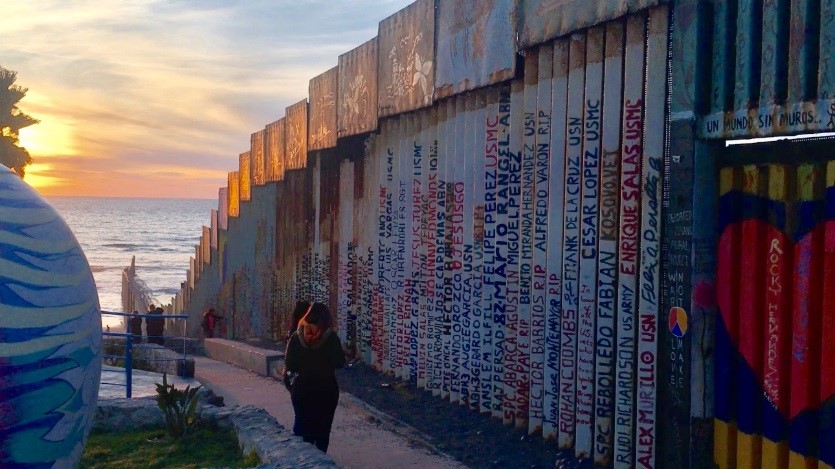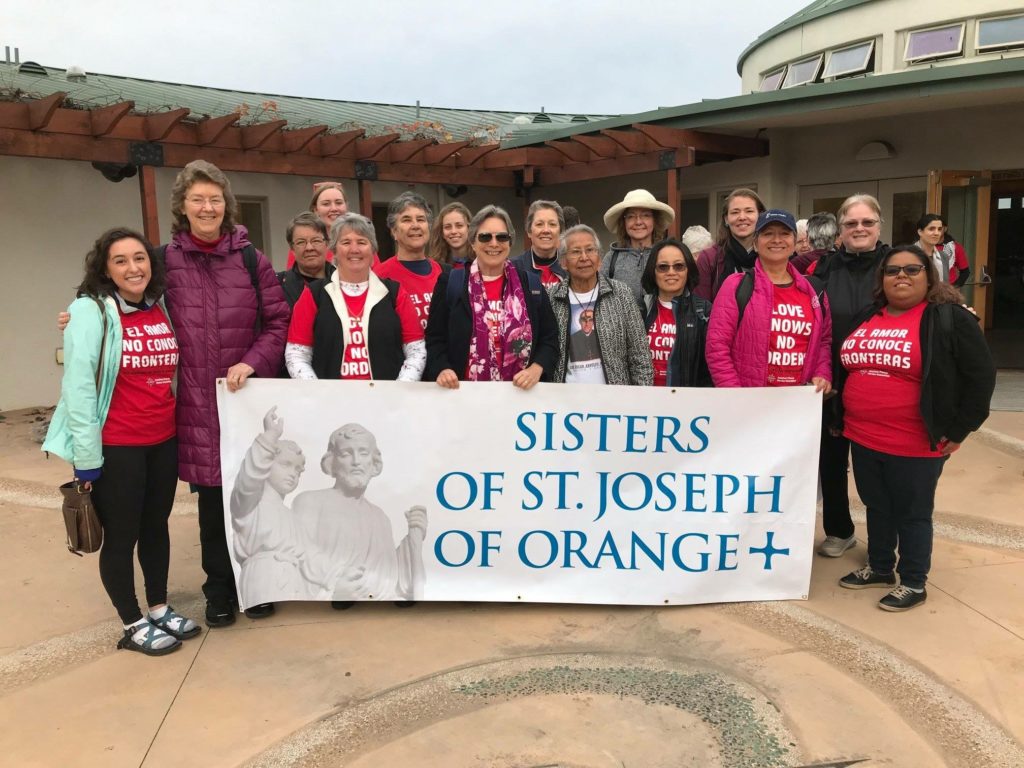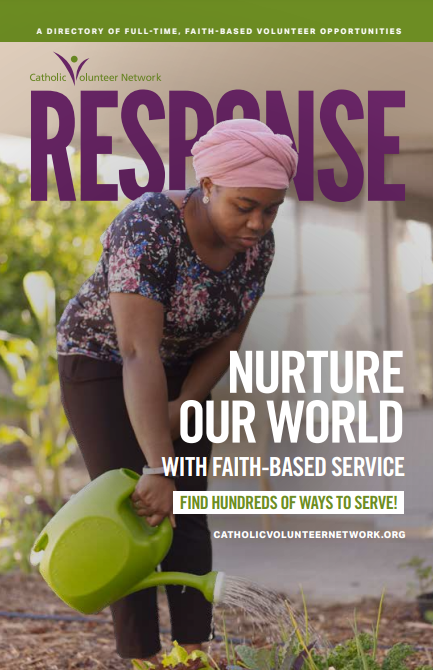In my last blog post, I spoke about an unforgettable journey I took with my program to Tijuana, Mexico. At the end of that trip, we had the opportunity to visit the border wall which separates Tijuana from San Diego. But months before this incredible experience in Mexico, I had been to the border once before – on the San Diego side.
Serving in southern California, I encounter many people with mixed immigration statuses, and I also have been a part of a few immigrant solidarity movements and organizations. I joined an interfaith peaceful protest at the San Diego border, and it was breathtaking. The protest was organized by the American Friends Service Committee – a Quaker organization working for social justice through various focus areas including immigrant rights. A group of over 400 representatives from various faith traditions reverently walked to the border on the U.S. side. About 20 Sisters of St. Joseph of Orange were among the 400 people.
The walk to the border wall was intentional and heavy on my heart. The names of deceased immigrants (at the hands of detention centers or the grueling journey across the desert) were called out. In response, we exclaimed “Presente” to acknowledge that they are not forgotten. Upon arrival at the wall, around 100 people took the risk of being arrested by committing civil disobedience; 32 of them actually were arrested. Those who were committing civil disobedience remained peaceful and prayerful. Their crime was being too close to the wall. It was chilling to see the black, prison-like wall extending all the way into the ocean. It was even more chilling to see the numerous border patrol agents in riot gear creating a blockade in front of those committing civil disobedience, when all they were doing was kneeling in prayer. Those who were not committing civil disobedience, myself included, were just 40 meters further from the border.

U.S. side of the San Diego/Tijuana Border Wall.
Organizers from groups such as the Poor People’s Campaign led us in songs and rhythmic chants demanding justice for immigrants. Every time someone was arrested by border patrol agents, we sang these words: “We are not afraid. We are not afraid. We will stand for liberation `cause we know why we were made.” I raised my voice in song and in protest, because I knew there were people watching from the other side of that wall being energized with hope and love. It was a profound experience to be one with such a large group of faith-filled individuals advocating for immigration reform. We were all united under the premise that “Love Knows No Borders”. While some peers told me that they felt like protesting was not actually getting anything done, I completely disagree. We collectively made a statement not only to U.S. Border Patrol and the general public, but also to the people hoping to be granted asylum as they wait in Tijuana. The event was nonviolent yet bold. I was so proud to be with 20 Sisters of St. Joseph who were part of taking this stand.
After having been to the Tijuana-side of the border, my experience in San Diego touched me in a new way. The stark contrast between both sides of the same tall metal structure shocked me. On our trip to Mexico, our last stop was the very same wall as the one I saw at the protest—yet the difference in what I saw was astounding. Every inch of it was covered in art: images and words of hope and welcoming. While the art was beautiful, it represented to me so much more than just something pretty to look at and take selfies in front of. When the wall has become such a symbol of xenophobia in the United States, activists on the Mexican (and U.S.) side have not allowed it to become a symbol of fear. It is also a memorial to people who have been deported and sent back only to face death in their home countries. There was also a section paying homage to U.S. veterans who were deported, despite having served the United States as though it were truly their home. It is also apparent in the photo how close we could stand to the wall. In fact I touched the wall with my own fingers – the same wall which if I had even dared to touch on the San Diego side, I would have faced arrest. Seeing the beauty on this side, while also knowing of the ugliness that goes with our immigration system, was a spiritual experience. I was filled with a holy anger which has fueled my work throughout the rest of my service year.

Mexico side of the San Diego/Tijuana Border Wall.
I was very emotional while I was on both sides of the wall, but the very root of the word “emotion” comes from Latin meaning to “move”. This year has moved me to see the work I may be called to do. Though I will not become an immigration attorney, and I may not be able to spend every day protesting for humane immigrant rights, I know I have a voice. The question I must continually ask myself is, how am I using my voice for the good of others? A quote I recently read sums it up very well: “I decided it is better to scream. Silence is the real crime against humanity.” (Nadezhda Mandelstam) I feel really lucky to be part of the voices who are advocating for change and for social justice!
Be sure to follow CVN’s Blog on Thursdays to hear more from Luz and her fellow Serving with Sisters Contributors!
 Luz Peredo-Muniz is a volunteer with St. Joseph Worker, Orange and a CVN Serving with Sisters Contributor. This blog series is sponsored by our VOCARE Initiative, thanks to the support of the Conrad N. Hilton Foundation.
Luz Peredo-Muniz is a volunteer with St. Joseph Worker, Orange and a CVN Serving with Sisters Contributor. This blog series is sponsored by our VOCARE Initiative, thanks to the support of the Conrad N. Hilton Foundation.



 Thousands of faith-based service opportunities can be at your fingertips with the RESPONSE. Download the latest edition today!
Thousands of faith-based service opportunities can be at your fingertips with the RESPONSE. Download the latest edition today!
